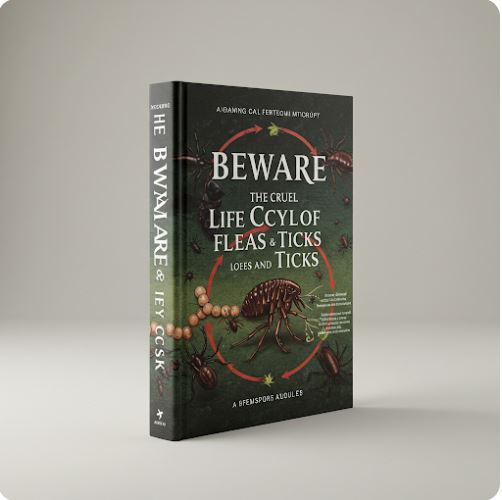Beware: The Cruel Life Cycle of Fleas and Ticks
Introduction to Fleas and Ticks
"Beware: The Cruel Life Cycle of Fleas and Ticks" Learn about fleas and ticks, their life cycles, and the significant health risks they pose to pets and humans. Discover effective prevention strategies and methods for managing infestations. This comprehensive guide provides insights into the behaviors of these parasites and emphasizes the importance of vigilance in maintaining a healthy home environment for both pets and their owners.
Fleas and ticks are ubiquitous parasites that pose significant challenges to both pets and humans. These small, blood-feeding organisms thrive in a variety of environments and can adapt remarkably well to changing conditions. They predominantly target mammals, including our beloved pets, and may even find their way into human homes, leading to various health complications and discomfort.
The relevance of fleas and ticks extends beyond their role as nuisances; they have substantial ecological impacts. In many ecosystems, these parasites serve as vectors for diseases, influencing both animal and human populations. They are known to transmit various pathogens, including bacteria, viruses, and protozoa, contributing to health issues such as Lyme disease, Rocky Mountain spotted fever, and tapeworm infestations. Understanding the life cycle of fleas and ticks is essential to mitigate the threats they pose. Their life cycles typically consist of four stages: egg, larva, pupa, and adult; each stage presents its own challenges for control and eradication.
Effective management of flea and tick populations relies heavily on recognizing their life cycle and behavior. For instance, environmental factors such as temperature and humidity significantly influence their reproductive patterns and survival. As a result, seasons can affect the prevalence of these parasites, making awareness and proactive measures crucial. Utilizing a combination of preventive measures—including regular veterinary consultations, proper grooming, and effective pest control techniques—can significantly reduce the risk of infestations. Ultimately, by enhancing our understanding of fleas and ticks, we can better protect our pets and ourselves from the various health implications and discomfort associated with these persistent parasites.
The Life Cycle of Fleas
The life cycle of fleas is a complex process that consists of four distinct stages: egg, larva, pupa, and adult. Understanding this life cycle is crucial for effective flea control and prevention in homes, as the various stages respond to different environmental conditions. Generally, the entire cycle can take as little as two weeks to several months, depending largely on temperature and humidity levels.
The first stage begins when an adult female flea lays eggs, typically in the host's bedding or on carpets. A single female can lay up to 50 eggs per day, leading to a rapid increase in flea populations. The eggs are small, white, and oval-shaped, often blend seamlessly into the environment. Under optimal conditions, these eggs hatch within two to ten days, progressing to the larva stage.
Flea larvae are not fully developed and resemble small, white worms. They are usually found in dark, moist areas where they can feed on organic matter, including adult flea feces. This stage lasts approximately five to 20 days, but can extend longer depending on environmental factors. Humidity and temperature play a significant role in the growth rate of larvae, ensuring that they thrive in warm conditions.
Next, the larva will spin a cocoon, entering the pupa stage. This is a crucial phase, as pupae are resistant to many environmental threats, including insecticides. The pupa can remain dormant for several months, waiting for specific stimuli, such as vibrations or increased carbon dioxide levels from potential hosts, to emerge as an adult flea. Once conditions are favorable—approximately 85% humidity and temperatures around 70°F to 85°F—the adult flea will emerge from the cocoon, ready to begin the life cycle anew.
Fleas are inherently prolific, contributing to their ability to infest homes and pets rapidly. This biological adaptability requires vigilant monitoring and preventive measures to control flea populations in living environments.
The Life Cycle of Ticks
Ticks undergo a complex life cycle consisting of four distinct stages: egg, larva, nymph, and adult. Each stage plays a critical role in the tick's development and its interaction with host animals, which are essential for their survival and reproduction. The life cycle begins when adult female ticks lay thousands of eggs in grassy or wooded areas. These eggs are the starting point for new tick generations, leading to the potential for infestations in the environment.
Once the eggs hatch, they produce six-legged larvae that are incredibly small and often difficult to see with the naked eye. These larvae require a blood meal to develop into the next stage of their life cycle. Typically, they latch onto small mammals, birds, or reptiles for nourishment, which also facilitates the transfer of potential pathogens. This blood-feeding activity marks a crucial moment in their life cycle, as it enables the larvae to mature into nymphs.
The nymph stage is particularly noteworthy because it is during this period that ticks are most likely to transmit diseases to their hosts. Nymphs are still very small but now possess eight legs. They seek larger hosts, often mammals, to obtain their next blood meal. If a nymph transmits pathogens during this stage, it can lead to serious health issues for the host, including Lyme disease and other tick-borne illnesses.
Finally, after feeding sufficiently, nymphs metamorphose into adult ticks. Adult ticks can take a wider range of hosts, including larger animals like deer and humans. Female ticks, post-feeding, will lay eggs and the cycle recommences. Understanding the life cycle of ticks is vital for implementing effective prevention strategies, as different control measures can be targeted at different stages of their development. This awareness is essential for mitigating the health risks associated with ticks and their parasites.
Health Risks Associated with Fleas
Fleas, small yet resilient parasites, pose significant health risks to both pets and humans. One of the primary concerns is the transmission of flea-borne diseases. Fleas are known vectors for various pathogens and parasites, including the bacterium Yersinia pestis, which causes plague, and Rickettsia spp., responsible for typhus. These pathogens can be transmitted to humans through scratches or bites from infected pets, putting individuals at risk, especially in areas where such diseases are prevalent.
Moreover, flea bites can trigger severe allergic reactions in both pets and humans. In pets, flea allergy dermatitis (FAD) is a common condition where the animal develops an intense itchiness due to an allergic response to flea saliva. This can lead to sores, hair loss, and secondary infections, ultimately affecting the pet's overall health and well-being. The constant scratching can also result in discomfort and distress, compounding the issue for the affected animal.
For humans, flea bites can cause red, itchy welts, and in some cases, may lead to more serious reactions, particularly in individuals with compromised immune systems or those predisposed to allergies. Infants and young children are especially vulnerable, as their skin is more sensitive. Fleas can also contribute to the spread of tapeworms. If a person inadvertently swallows an infected flea, they may contract a tapeworm infection, leading to digestive issues and discomfort.
The presence of fleas can severely impact the quality of life for both pets and their owners. As such, controlling flea populations is crucial for maintaining a healthy environment. Regular veterinary check-ups, effective flea prevention measures, and thorough cleaning of living spaces can significantly reduce the risk posed by these parasites, ensuring both pets and humans remain safe from potential flea-related health issues.
Health Risks Associated with Ticks
Ticks are more than just a nuisance; they pose significant health risks to both humans and animals. These ectoparasites can transmit a variety of diseases, the most prominent of which include Lyme disease and Rocky Mountain spotted fever. Lyme disease, caused by the Borrelia burgdorferi bacterium, often begins with a hallmark symptom: a characteristic rash resembling a "bull's-eye." This rash typically appears within three to 30 days after a tick bite. Other symptoms may follow and can range from fatigue, fever, and headaches to joint pain. Untreated Lyme disease can lead to more severe issues, such as neurological problems or arthritis, highlighting the importance of early detection and treatment.
Rocky Mountain spotted fever, on the other hand, is caused by the Rickettsia rickettsii bacterium and is transmitted primarily by the American dog tick. Symptoms usually manifest within 2 to 14 days following a bite and can include a sudden onset of fever, headache, and a rash that may develop into a more serious condition if not addressed promptly. This disease can be particularly severe, leading to complications such as organ failure or even death. Awareness of these symptoms and timely medical intervention are crucial in minimizing long-term effects.
The risks associated with tick bites extend beyond immediate health effects. Chronic conditions may develop owing to delayed treatment, resulting in prolonged periods of discomfort and potential secondary infections. Moreover, the rising incidence of tick-borne illnesses emphasizes the need for preventive measures, especially in endemic areas. Maintaining vigilance when engaging in outdoor activities, using effective repellents, and regularly checking for ticks after exposure can significantly reduce the likelihood of contracting these dangerous diseases. Understanding the health risks associated with ticks is essential for ensuring a safe and healthy lifestyle.
Effective Prevention Strategies for Fleas
Preventing a flea infestation requires a comprehensive approach that addresses both pets and their environment. One of the most effective strategies is the regular application of topical treatments. These products—available as spot-on treatments, sprays, or oral medications—are designed to kill fleas at various life stages. It is essential to consult a veterinarian to choose the right product for your pet's specific needs and health conditions. Furthermore, it is advisable to administer these treatments as per the recommended schedule, often monthly, to ensure optimal protection against fleas.
In addition to treating pets, it is crucial to implement environmental measures. Fleas thrive in warm, humid conditions, which makes maintaining a clean living environment a vital aspect of prevention. Regular vacuuming of carpets, rugs, and furniture helps remove flea eggs and larvae. Pay special attention to areas where pets rest or spend time, such as bedding and play areas. After vacuuming, dispose of the vacuum bag or empty the canister outside to prevent re-infestation.
Washing pet bedding and toys in hot water on a regular basis also helps eliminate any fleas that may be hiding within. In cases of severe infestations, it may be necessary to treat your home with insecticides or flea sprays specifically designed for indoor use. Always follow safety instructions when using such products, especially in homes with children or other pets.
Regular grooming practices, including brushing your pet's coat frequently, can also help detect early signs of fleas and prevent infestations from taking hold. Grooming not only assists in removing adult fleas but allows for close inspection of your pet's fur and skin. By employing these effective prevention strategies, pet owners can significantly reduce the risk of encountering fleas and ensure a healthier, happier environment for their animals.
Effective Prevention Strategies for Ticks
To effectively prevent tick bites and mitigate the risk of infestations, it is essential to adopt a multi-faceted approach that combines personal vigilance, appropriate use of repellents, and environmental management. One of the first lines of defense against ticks is the application of high-quality tick repellents. Products containing active ingredients such as DEET, picaridin, or oil of lemon eucalyptus can provide significant protection when applied to exposed skin and clothing. It is advisable to carefully follow the manufacturer's instructions to ensure maximal efficacy and safety.
In addition to using repellents, thorough post-outdoor activity checks are crucial in keeping ticks at bay. After spending time in wooded areas, tall grass, or brush, individuals should perform meticulous checks on themselves and their pets. This includes examining places such as under the arms, behind the knees, and on the scalp, as ticks often seek sheltered s to attach themselves. If a tick is found, it should be removed promptly using fine-tipped tweezers, grasping it as close to the skin's surface as possible.
Creating a tick-safe environment around the home can also play a vital role in prevention. Homeowners should consider landscaping changes, such as keeping grass short and clearing brush and leaf litter, to reduce tick habitats. Additionally, establishing a barrier of wood chips or gravel between wooded areas and yards can help prevent ticks from migrating into outdoor spaces where pets and children frequently play.
By integrating these prevention strategies—utilizing effective tick repellents, performing regular checks, and maintaining a tick-safe yard—individuals can significantly minimize their risk of tick bites and the complications associated with tick-borne diseases.
Home Remedies vs. Professional Treatments
When faced with a flea or tick infestation, pet owners often find themselves deciding between home remedies and professional treatments. Both approaches offer unique benefits and challenges, making it essential to understand their effectiveness, safety, and convenience in managing these persistent pests.
Home remedies can be appealing due to their cost-effectiveness and accessibility. Commonly utilized options include essential oils, vinegar solutions, and diatomaceous earth. These methods aim to repel or kill fleas and ticks without the use of harsh chemicals. For instance, essential oils like lavender and peppermint are known for their natural pest-repellent properties, while vinegar creates an inhospitable environment for these pests. However, the efficacy of such remedies can vary significantly. Some may provide temporary relief but lack the ability to eliminate the infestation completely. Additionally, improper use or concentration of certain substances may pose risks to pets and humans alike, emphasizing the need for caution.
On the other hand, professional treatments, such as veterinary-prescribed medications or fumigation services, offer a tailored approach to tackling flea and tick problems. These methods are often designed with specific dosages and active ingredients that ensure rapid and effective results. For example, topical treatments and oral medications prescribed by veterinarians can eradicate adult fleas and disrupt their reproductive cycle. While these options may come with a higher upfront cost, their long-term effectiveness and safety are generally well-established, providing pet owners peace of mind.
In terms of convenience, professional treatments usually require less ongoing effort as they often involve one-time or monthly applications, whereas home remedies may necessitate consistent repetition. Ultimately, the choice between home remedies and professional treatments should be informed by the severity of the infestation, the specific needs of the pet, and the concerns of the household. Understanding the strengths and limitations of each approach will empower pet owners to make informed decisions on pest management, optimizing pet health and comfort.
Conclusion: The Importance of Vigilance
Fleas and ticks pose significant threats not only to pets but also to household members, creating a cycle of distress that impacts overall comfort and health. Throughout this article, we have explored the life cycle of these parasites, highlighting their resilience and ability to reproduce swiftly. Understanding this life cycle is crucial in recognizing the urgency of prevention methods that can keep these pests at bay.
To minimize the risk of flea and tick infestations, it is essential for pet owners to remain vigilant. Regularly inspecting pets for these parasites can lead to early detection and intervention, thus preventing a more extensive infestation. Furthermore, maintaining a clean and well-ordered living environment significantly reduces the potential for fleas and ticks to thrive. This includes frequent vacuuming, washing pet bedding, and keeping outdoor areas tidy.
Additionally, considering preventive treatments, such as topical solutions or oral medications, can serve as a proactive approach in safeguarding pets from these parasitic threats. These interventions should be administered consistently, aligning with veterinarian recommendations, to ensure maximum effectiveness. It is also important to educate oneself about the signs of flea and tick presence so that timely action can be taken when necessary.
In light of the serious implications associated with flea and tick infestations—ranging from discomfort for pets to potential transmission of diseases—being proactive rather than reactive becomes imperative. By prioritizing vigilance and implementing comprehensive prevention strategies, pet owners can create a protective barrier against these persistent pests. Taking these steps not only enhances the well-being of pets but also fosters a healthier home environment.
Loja de Livros
Ofertas | Para Você | Mais Vendidos | Lançamentos | Indicações | Kindle Unlimited | eBooks Kindle | Livros Usados | Audible




















